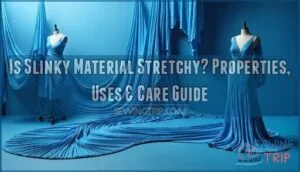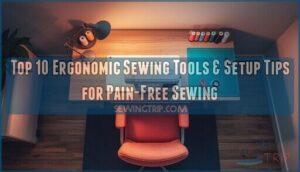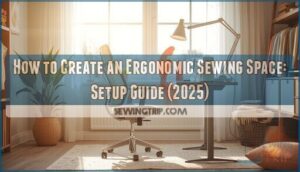This site is supported by our readers. We may earn a commission, at no cost to you, if you purchase through links.

Think of it as the fabric equivalent of a yoga instructor—flexible, forgiving, and always ready to bounce back. Whether you’re reaching, bending, or simply shifting in your seat, slinky fabric adapts without losing its drape or developing saggy spots.
This combination of synthetic durability and natural-fiber softness makes it a go-to for everything from everyday tops to activewear that needs to keep pace with your movements.
Table Of Contents
- Key Takeaways
- What is Slinky Fabric?
- Does slinky fabric stretch?
- What is Slinky made of?
- Can slinky fabric be see-through?
- Can slinky be dyed?
- What is slinky acetate jersey fabric?
- Is slinky material stretchy?
- What is the difference between slinky fabric and other stretchy fabrics?
- What are the best ways to care for slinky fabric?
- How can I style slinky fabric to flatter my figure?
- Conclusion
Key Takeaways
- Slinky fabric genuinely stretches in all directions thanks to its knit construction that combines acetate and viscose fibers with spandex (typically 9%), delivering 40–80% stretch beyond original length while maintaining over 96% elastic recovery so it bounces back to shape after every wear.
- The material’s acetate-viscose blend naturally resists wrinkles and requires minimal care—you can machine wash it in cool water, skip the dryer for air drying, and forget about ironing since wrinkles fall out when you hang it overnight.
- Slinky fabric works across all body types because its drape coefficient of 0.25 to 0.40 creates a flattering flow that skims curves without clinging, while the four-way stretch provides bodycon confidence and movement freedom without restriction or shapewear.
- Despite its comfort and versatility, slinky fabric carries significant environmental costs, including 17 kg of CO₂ per kilogram produced, microfiber shedding of up to 700,000 plastic particles per wash, and synthetic materials that persist in landfills for 200+ years without biodegrading.
What is Slinky Fabric?
Ever wonder why some fabrics feel like they’re hugging you in all the right ways? That’s slinky fabric at work. It’s this clever blend of acetate and viscose that’s knitted (not woven) into something pretty special.
Here’s the thing about how it’s made: the fibers are knitted together in a way that lets the fabric stretch in every direction. That four-way stretch is what makes it move with your body instead of against it. The acetate brings durability, while the viscose keeps things soft and breathable. The result? A lightweight fabric that drapes like a dream and bounces back no matter how much you wear it.
If you’ve ever slipped on something that just feels right—flattering, comfortable, moves when you move—chances are you’re wearing slinky fabric. It’s become one of those go-to materials in fashion because it works for so many different styles and body types.
Does slinky fabric stretch?
Here’s what you need to know—from the way it drapes and moves to the fact that it practically takes care of itself.
However, it needs stabilizers like clear elastic to prevent over-stretching and maintain shape retention over time.
What is Slinky made of?
What really sets slinky fabric apart is just how stretchy and resilient it is.
This synthetic fiber content—primarily acetate and polyester—creates fiber elasticity through manufacturing processes that interlock the material’s structure, delivering that signature smooth, stretchy drape you’ll recognize instantly.
Can slinky fabric be see-through?
Fabric Opacity in slinky knits depends heavily on Knit Density and Color Matters—lighter shades and looser weaves can be sheer.
Check your Undergarment Choice and test in various Lighting Conditions before wearing, or add interfacing for coverage.
Can slinky be dyed?
Want to transform your slinky pieces? Dyeing slinky fabric depends entirely on fiber content—acetate and viscose blends accept dye beautifully using appropriate dyeing methods, though color fastness varies.
Test patterning options on scraps first to assess dye compatibility and fabric characteristics and care requirements.
What is slinky acetate jersey fabric?
Acetate Composition blends synthetic and natural fibers in this Jersey Knit construction, creating Slinky material that’s especially stretchy.
The Manufacturing Process produces lightweight fabric characteristics and care requirements centered on gentle care, while Drape Properties and Fabric Weight deliver fluid movement perfect for comfortable garments.
Is slinky material stretchy?
If you’ve ever wondered whether slinky material lives up to its name—yes, it does stretch. Thanks to its knit construction and elastane fibers (often called Lycra), slinky knit fabric offers impressive stretch recovery, though it can over-stretch when worn, which is why stabilizers are needed for structural stability.
The fabric’s natural composition means you get wrinkle-free wear without any extra effort.
What is the difference between slinky fabric and other stretchy fabrics?
While most stretchy fabrics rely heavily on Lycra or spandex, slinky fabric gets its stretch from a knit structure combining acetate and viscose.
This knit fabric composition offers enhanced drape and lighter weight compared to other knit fabric types, though stretch recovery and cost analysis often favor traditional Lycra blends for activewear.
What are the best ways to care for slinky fabric?
Ironically, this low-maintenance fabric still demands specific washing techniques to stay in peak condition.
Machine wash your slinky pieces in cold water on a gentle cycle, then tumble dry on low heat—the wrinkle resistance means you can skip ironing entirely, making storage solutions simple and care straightforward.
How can I style slinky fabric to flatter my figure?
You can work slinky’s natural drape to your advantage by choosing simple patterns with vertical lines. These elongate your silhouette while the garment flows over curves without clinging awkwardly, especially when you add layering pieces or strategic accessories.
Conclusion
Imagine this: you’re slipping into your favorite slinky top, feeling the fabric glide and stretch as you move—no tugging, no resistance, just pure comfort. So, is slinky material stretchy? Absolutely.
Its four-way stretch, wrinkle-resistant drape, and easy-care nature make it a wardrobe workhorse that conforms to your body and lifestyle. Whether you’re dressing up for an evening out or keeping it casual, slinky fabric delivers flexibility without sacrificing style. It’s the reliable friend your closet didn’t know it needed.
Slinky fabric isn’t just about fit—it glides over your shape, almost like a gentle hug. With a drape coefficient between 0.25 and 0.40, it smooths your silhouette by skimming curves instead of sticking to them.
Slinky fabric glides over your body like a gentle hug, skimming curves with a drape that smooths rather than clings
That’s what makes the drape so important:
In other words, the fabric works with you instead of fighting you—something everyone can appreciate, no matter their shape or size.
Slinky fabrics need TLC to maintain their stretch and drape. The key is treating them gently—use a mild detergent, wash in cool water, and stick to delicate cycles.
Less washing is actually better since it preserves the fabric’s integrity.
More manufacturers are rethinking how they make slinky fabric—and the numbers show it’s working. Today, about 35% of polyester comes from recycled PET bottles instead of virgin materials. Closed-loop dyeing systems are cutting water use by up to 15 gallons per yard.
[Keypoints]When you’re shopping, a few things signal genuine commitment:
- Recycled materials such as ECONYL nylon or repurposed polyester
- Eco-certifications like OEKO-TEX, Bluesign, or GOTS
- Ethical labor practices verified through supplier audits
- Water usage reductions via solution-dye and closed-loop processes
This isn’t niche anymore. The sustainable fabrics market hit $29.1 billion in 2023, and brands are responding because buyers actually care.
Slinky fabric gets its signature stretch from a smart mix of acetate and viscose fibers woven together in a special knit.
The acetate and polyester content creates natural elasticity through the way the fibers interlock during manufacturing—that’s what gives you that smooth, drapey feel the material’s known for.
You pull on your slinky top and it just moves with you—no fight, no bunching. That’s the whole point. Is slinky material stretchy? Yes, and that’s why it works.
The fabric stretches in every direction, resists wrinkles, and washes easily. It fits your body without clinging awkwardly, making it practical for date night or lazy Sunday. Slinky isn’t flashy, but it does the job reliably.
- https://www.bu.edu/moss/files/2014/10/IJNM_2014_Holmes.pdf
- https://researchportal.hw.ac.uk/files/62095721/The_kinematics_and_static_equilibria_of_a_Slinky.pdf
- http://www.scielo.org.co/scielo.php?script=sci_arttext&pid=S0123-30332015000200011
- https://studylib.net/doc/8179476/the-hanging-slinky
- https://www.jamesspring.com/news/invention-of-the-slinky/






